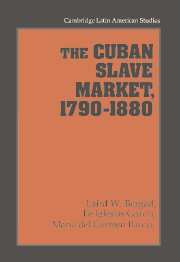Book contents
- Frontmatter
- Contents
- Tables and figures
- Preface and acknowledgments
- Glossary
- 1 Introduction: Prices and the historiography of slavery
- 2 Sources and methods of data collection
- 3 The development of African slavery and Cuban economic history
- 4 The price structure of the Cuban slave market, 1790–1880
- 5 Regional variations in the Cuban slave market: Havana, Santiago, and Cienfuegos
- 6 Coartación and letters of freedom
- 7 Conclusions and comparative perspectives
- Appendix A Nominal and real slave prices using international price indexes
- Appendix B Statistical data base on the Cuban slave market
- Bibliography
- Index
- CAMBRIDGE LATIN AMERICAN STUDIES
6 - Coartación and letters of freedom
Published online by Cambridge University Press: 22 March 2010
- Frontmatter
- Contents
- Tables and figures
- Preface and acknowledgments
- Glossary
- 1 Introduction: Prices and the historiography of slavery
- 2 Sources and methods of data collection
- 3 The development of African slavery and Cuban economic history
- 4 The price structure of the Cuban slave market, 1790–1880
- 5 Regional variations in the Cuban slave market: Havana, Santiago, and Cienfuegos
- 6 Coartación and letters of freedom
- 7 Conclusions and comparative perspectives
- Appendix A Nominal and real slave prices using international price indexes
- Appendix B Statistical data base on the Cuban slave market
- Bibliography
- Index
- CAMBRIDGE LATIN AMERICAN STUDIES
Summary
Coartados
From the early colonial period slaves had the right to begin the purchase of freedom by making a down payment on their market values. Referred to as coartados, these slaves had a series of prerogatives not available to those unable to begin this process. Their legal status was changed from slave to coartado and they were designated as such in all official legal documents, despite remaining enslaved with all of the arbitrary obligations and controls imposed by masters. They did not have a degree of freedom greater than slaves who had not begun the process of coartación.
Yet, there were distinctions between the slave and the coartado. The most important was that the latter's price was fixed at the value assigned when the first down payment on freedom was made, and it could not be altered, in theory at least, even if actual market prices increased later. The price of freedom established at the inception of the process was transferred if the coartado was sold. According to custom and written into law in the slave code of 1842, the coartado had the right to find a new master if so desired, and the owner was obligated to sell the coartado if this was requested and a purchaser found. Additionally, if the coartado was rented out or worked earning a salary, which was not unusual in urban centers, he or she had the right to a percentage of the rental fee or salary paid commensurate with the share owned.
- Type
- Chapter
- Information
- The Cuban Slave Market, 1790–1880 , pp. 122 - 142Publisher: Cambridge University PressPrint publication year: 1995
- 1
- Cited by

